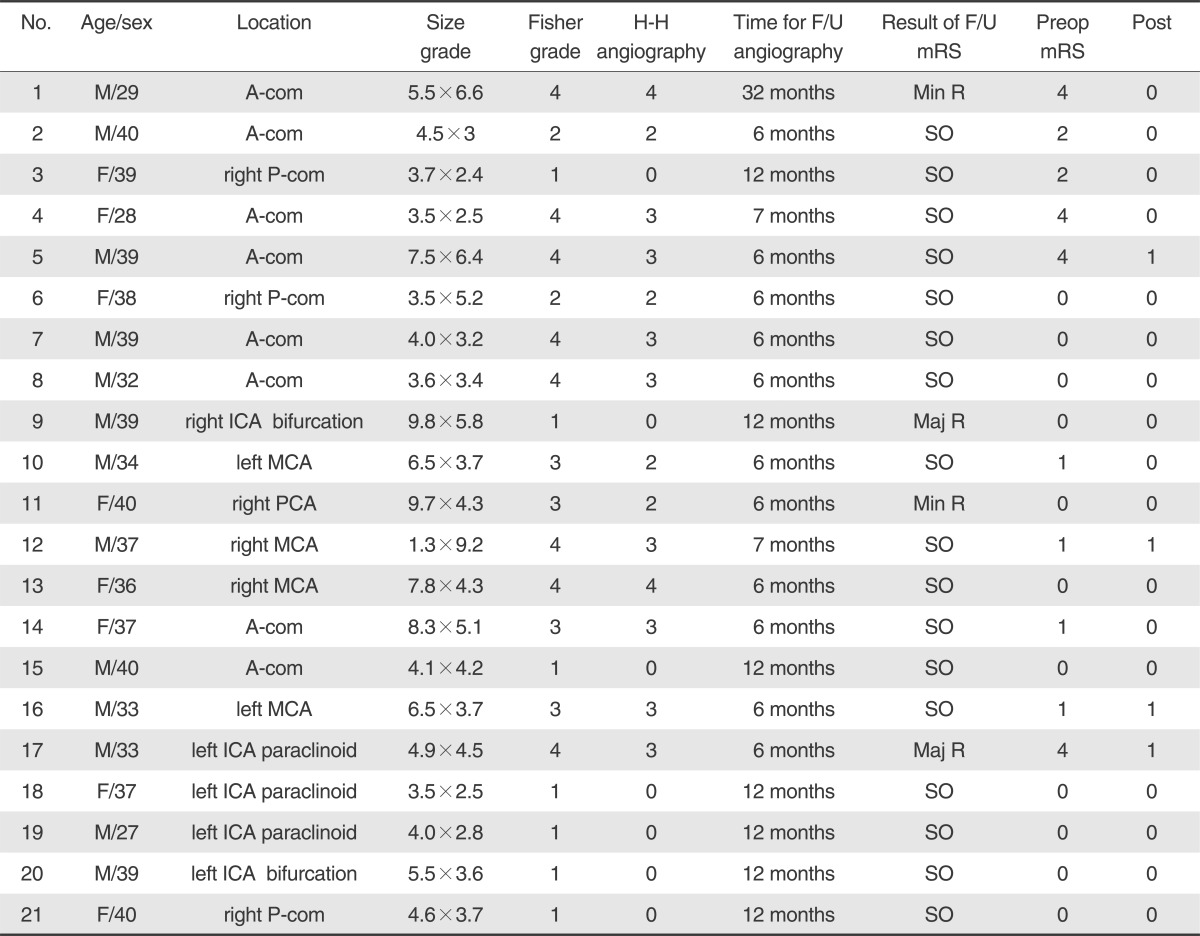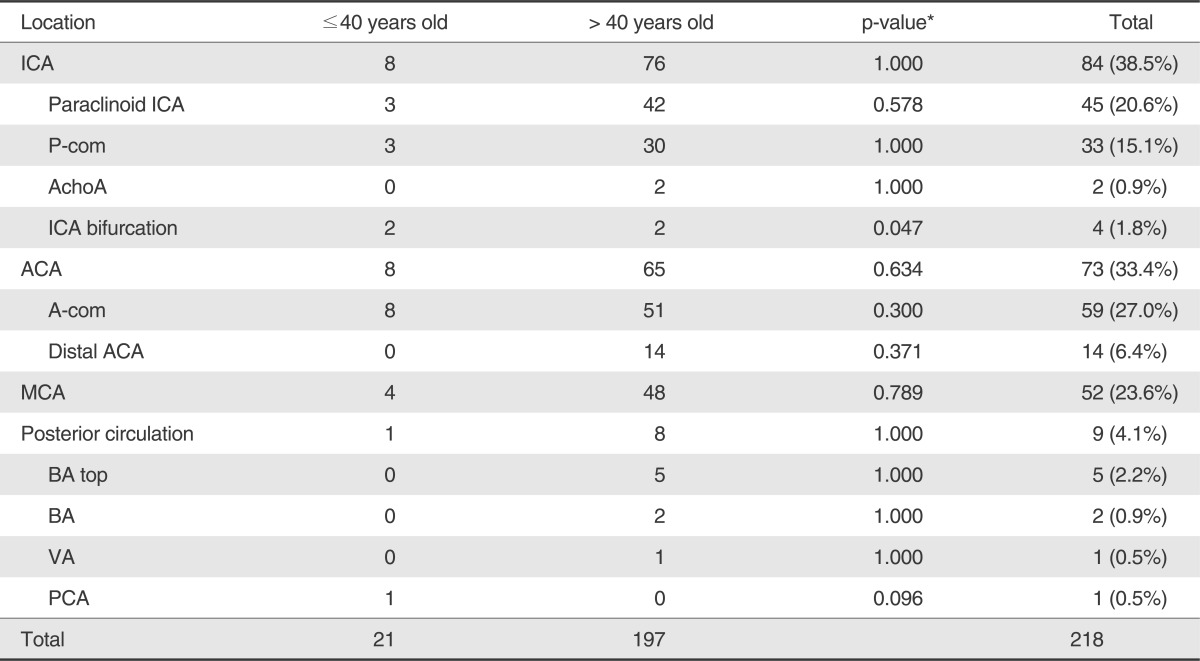1. Cognard C, Pierot L, Boulin A, Weill A, Tovi M, Castaings L, et al. Intracranial aneurysms: endovascular treatment with mechanical detachable spirals in 60 aneurysms. Radiology. 1997; 202:783–792. PMID:
9051034.

2. Cognard C, Weill A, Castaings L, Rey A, Moret J. Intracranial berry aneurysms: angiographic and clinical results after endovascular treatment. Radiology. 1998; 206:499–510. PMID:
9457205.

3. Fernandez Zubillaga A, Guglielmi G, Vinuela F, Duckwiler GR. Endovascular occlusion of intracranial aneurysms with electrically detachable coils: correlation of aneurysm neck size and treatments results. AJNR Am J Neuroradiol. 1994; 15:815–820. PMID:
8059647.
4. Guglielmi G, Viñuela F, Dion J, Duckwiler G. Electrothrombosis of saccular aneurysms via endovascular approach. II. Preliminary clinical experience. J Neurosurg. 1991; 75:8–14. PMID:
2045924.
5. Guglielmi G, Viñuela F, Duckwiler G, Dion J, Lylyk P, Berenstein A, et al. Endovascular treatment of posterior circulation aneurysms by electrothrombosis using electrically detachable coils. J Neurosurg. 1992; 77:515–524. PMID:
1527608.

6. Koebbe CJ, Veznedaroglu E, Jabbour P, Rosenwasser RH. Endovascular management of intracranial aneurysms: current experience and future advances. Neurosurgery. 2006; 59:S93–S102. PMID:
17053622.

7. Molyneux A, Kerr RS, Yu LM, Clarke M, Sneade M, Yarnold JA, et al. International Subarachnoid Aneurysm Trial (ISAT) of neurosurgical clipping versus endovascular coiling in 2143 patients with ruptured intracranial aneurysms: a randomised trial. Lancet. 2002; 360:1267–1274. PMID:
12414200.

8. Cognard C, Weill A, Spelle L, Piotin M, Castaings L, Rey A, et al. Long-term angiographic follow-up of 169 intracranial berry aneurysms occluded with detachable coils. Radiology. 1999; 212:348–356. PMID:
10429689.

9. Fiorella D, Albuquerque FC, McDougall CG. Durability of aneurysm embolization with matrix detachable coils. Neurosurgery. 2006; 58:51–59. PMID:
16385329.

10. Murayama Y, Nien YL, Duckwiler G, Gobin YP, Jahan R, Frazee J, et al. Guglielmi detachable coil embolization of cerebral aneurysms: 11 years' experience. J Neurosurg. 2003; 98:959–966. PMID:
12744354.

11. Ng P, Khangure MS, Phatouros CC, Bynevelt M, ApSimon H, McAuliffe W. Endovascular treatment of intracranial aneurysms with Guglielmi detachable coils: analysis of midterm angiographic and clinical outcomes. Stroke. 2002; 33:210–217. PMID:
11779912.
12. Raymond J, Guilbert F, Weill A, Georganos SA, Juravsky L, Lambert A, et al. Long-term angiographic recurrences after selective endovascular treatment of aneurysms with detachable coils. Stroke. 2003; 34:1398–1403. PMID:
12775880.

13. Thornton J, Debrun GM, Aletich VA, Bashir Q, Charbel FT, Ausman J. Follow-up angiography of intracranial aneurysms treated with endovascular placement of Guglielmi detachable coils. Neurosurgery. 2002; 50:239–249. PMID:
11844258.

14. Hourihan MD, Gates PC, McAllister VL. Subarachnoid hemorrhage in childhood and adolescence. J Neurosurg. 1984; 60:1163–1166. PMID:
6726359.

15. Wojtacha M, Bazowski P, Mandera M, Krawczyk I, Rudnik A. Cerebral aneurysms in childhood. Childs Nerv Syst. 2001; 17:37–41. PMID:
11219621.

16. Ostergaard JR. A long-term follow-up study of juvenile aneurysm patients. Acta Neurochir (Wien). 1985; 77:103–110. PMID:
4072780.
17. Ostergaard JR. Aetiology of intracranial saccular aneurysms in childhood. Br J Neurosurg. 1991; 5:575–580. PMID:
1772602.
18. Pasqualin A, Mazza C, Cavazzani P, Scienza R, DaPian R. Intracranial aneurysms and subarachnoid hemorrhage in children and adolescents. Childs Nerv Syst. 1986; 2:185–190. PMID:
3779680.

19. Grunwald IQ, Papanagiotou P, Struffert T, Politi M, Krick C, Gül G, et al. Recanalization after endovascular treatment of intracerebral aneurysms. Neuroradiology. 2007; 49:41–47. PMID:
17094000.

20. Lempert TE, Malek AM, Halbach VV, Phatouros CC, Meyers PM, Dowd CF, et al. Endovascular treatment of ruptured posterior circulation cerebral aneurysms: clinical and angiographic outcomes. Stroke. 2000; 31:100–110. PMID:
10625723.
21. Pandey AS, Koebbe C, Rosenwasser RH, Veznedaroglu E. Endovascular coil embolization of ruptured and unruptured posterior circulation aneurysms: review of a 10-year experience. Neurosurgery. 2007; 60:626–627. PMID:
17415199.
22. Roy D, Milot G, Raymond J. Endovascular treatment of unruptured aneurysm. Stroke. 2001; 32:1998–2004. PMID:
11546888.
23. Sluzewski M, van Rooij WJ, Rinkel GJ, Wijnalda D. Endovascular treatment of ruptured intracranial aneurysms with detachable coils: long-term clinical and serial angiographic results. Radiology. 2003; 227:720–724. PMID:
12773678.

24. Kawanabe Y, Sadato A, Taki W, Hashimoto N. Endovascular occlusion of intracranial aneurysms with Guglielmi detachable coils: correlation between coil packing density and coil compaction. Acta Neurochir (Wien). 2001; 143:451–455. PMID:
11482694.

25. Kuether TA, Nesbit GM, Barnwell SL. Clinical and angiographic outcomes, with treatment data, for patients with cerebral aneurysms treated with Guglielmi detachable coils: a single-center experience. Neurosurgery. 1998; 43:1016–1025. PMID:
9802844.

26. Soeda A, Sakai N, Sakai H, Iihara K, Nagata I. Endovascular treatment of asymptomatic cerebral aneurysms: anatomic and technical factors related to ischemic events and coil stabilization. Neurol Med Chir (Tokyo). 2004; 44:456–465. PMID:
15600280.







 PDF
PDF ePub
ePub Citation
Citation Print
Print





 XML Download
XML Download